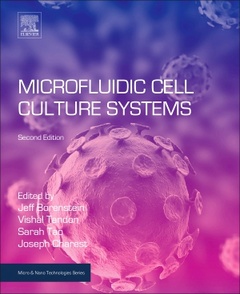Description
Microfluidic Cell Culture Systems (2nd Ed.)
Micro and Nano Technologies Series
Coordinators: Borenstein Jeffrey T, Tandon Vishal, Tao Sarah L, Charest Joseph L.
Language: English
Subjects for Microfluidic Cell Culture Systems:
Keywords
2D and 3D culture; 3-D; Astrocytes; Blood-brain barrier; Blood-retinal barrier (BRB); Cardiac myocyte; Cardiotoxicity; Cell culture; Cell-substrate interactions; Cell-topography interactions; Chip; Choroidal neovascularization; Contractility; Disease modeling; Drug delivery system; Drug screening; Electrophysiology; Extracellular matrix; Flow; Flow-induced shear stress; Glucose reabsorption; Hepatocyte; In vitro; In vitro kidney tissue models; Induced pluripotent stem cells; Kidney cell types; Kidney disease; Liver; Lung-on-a-chip; Microelectromechanical systems (MEMS); Microfabrication; Microfluidic; Microfluidics; Microglia; Microphysiological; Microphysiological systems; Nanomedicine; Nanotopography; Neural injury; Neural toxicity models; Neurodegenerative disease; Neurodevelopmental disease; Neurons; Neuropsychiatric disease; Organ-on-chips; Patient-derived cells; PDMS; Phenotypic screen; Physiological function; Porous membranes and scaffolds; Precision medicine; Retina-on-a-chip; Retinopathy; Shear stress; Stem cell differentiation; Substrate stiffness; Substrate topography; Surface chemistry; Tissue engineering; Toxicity testing
396 p. · 19x23.3 cm · Paperback
Description
/li>Contents
/li>Readership
/li>Biography
/li>Comment
/li>
Techniques for microfabricating intricate microfluidic structures that mimic the microenvironment of tissues and organs, combined with the development of biomaterials with carefully engineered surface properties, have enabled new paradigms in and cell culture-based models for human diseases. The dimensions of surface features and fluidic channels made accessible by these techniques are well-suited to the size scale of biological cells. Microfluidic Cell Culture Systems applies design and experimental techniques used in in microfluidics, and cell culture technologies to organ-on-chip systems.
This book is intended to serve as a professional reference, providing a practical guide to design and fabrication of microfluidic systems and biomaterials for use in cell culture systems and human organ models. The book covers topics ranging from academic first principles of microfluidic design, to clinical translation strategies for cell culture protocols. The goal is to help professionals coming from an engineering background to adapt their expertise for use in cell culture and organ models applications, and likewise to help biologists to design and employ microfluidic technologies in their cell culture systems.
This 2nd edition contains new material that strengthens the focus on in vitro models useful for drug discovery and development. One new chapter reviews liver organ models from an industry perspective, while others cover new technologies for scaling these models and for multi-organ systems. Other new chapters highlight the development of organ models and systems for specific applications in disease modeling and drug safety. Previous chapters have been revised to reflect the latest advances.
Part 1: Introduction 1. Microfluidic Cell Culture Technologies 2. Inertial microfluidics for stem cell isolation 3. Microfluidic Structures for Controlling Stem Cell Microenvironments 4. Microfluidic cell culture platforms with embedded nanoscale features 5. Microfluidic Vascular Networks for Engineered Tissues 6. Direct Write Assembly of Organ Models 7. 3D Bioprinting for Organ Models
Part II: Organ-Specific Disease and Drug Safety Models 8. Microfabricated Kidney Tissue Models 9. Microfluidic Hepatotoxicity Platform 10. Dynamic Gastrointestinal and Pulmonary Organ Models 11. Cardiac Models 12. Neural Tissue Microphysiological Systems 13. Models of the Female Reproductive Tract 14. Microscale Models of Inflammatory Diseases 15. Blood-Retinal Barrier-on-a –chip 16. Human blinking eye-on-a chip 17. Circulating tumor cell cultures for evaluation of anticancer treatment
Part III: Technologies for Sensing, Multiplexed and Interconnected Organ Models 18. Live Cell Analysis Under Shear Flow 19. High Throughput Flow Systems for Cardiovascular Research 20. Phaseguide technology for connected organ models 21. Electromagnetically microactuated platforms for dynamic microphysiological systems 22. Interconnected organ models for skin and liver 23. Heart-Liver-Vascular Interconnected Microphysiological Systems 24. Rocking Platform Technology for Interconnected Organ Models
Academic scientists working in areas related to cell and tissue culture, industry scientists working on drug discovery, safety, and drug screening, and clinical researchers working toward regenerative medicine technologies
Vishal Tandon is a Research Fellow at the Biomedical Engineering Center, Draper University, USA. His research focuses on the design and testing of implantable microfluidic devices for drug delivery into the ear.
Sarah Tao is Senior Manager, New Technologies at CooperVision, Inc. She was previously Senior Member Technical Staff, MEMS Design Group at Draper University, and Research Professor Equivalent, Bioengineering and Therapeutic Sciences at the University of California, San Francisco, USA. Her research interests lie in the areas of biomaterials, nanotechnology, regenerative medicine, drug delivery, BioMEMS, microfluidics and cell culture.
Dr. Charest is director of in vitro model and organ-assist work at Draper Laboratory. The work of his teams leverages micro- and nano-fabrication along with advanced machining techniques to create systems which recapitulate native tissue and organ architecture, morphology, and function in vitro. The systems span applications from medical devices to screening platforms for pharmaceuticals, and impact fields of use in various organ and tissue types such as tumor, kidney, vascular tissue and lung. Dr. Charest gradua
- Provides design and operation methodology for microfluidic and microfabricated materials and devices for organ-on-chip disease and safety models. This is a rapidly expanding field that will continue to grow along with advances in cell biology and microfluidics technologies.
- Comprehensively covers strategies and techniques ranging from academic first principles to industrial scale-up approaches. Readers will gain insight into cell-material interactions, microfluidic flow, and design principles.
- Offers three fundamental types of information: 1) design principles, 2) operation techniques, and 3) background information/perspectives. The book is carefully designed to strike a balance between these three areas, so it will be of use to a broad range of readers with different technical interests and educational levels.

